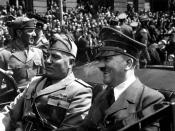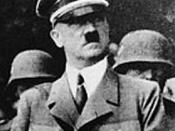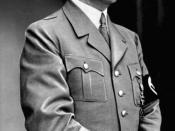Hitler and his Nazi party never had a majority of votes at elections. The points and promises that Hitler gave only appealed to a limited number of people, which accounted for 1/3rd of the population only. At the party's highest peak, the Nazi party had around 40% of the votes in the Reichstag, hardly enough to gain power. So how is it that in 1934, despite his relatively low power, was Hitler made chancellor?
Hitler came to extreme actions between 1930 and 1932 to gain power. Many fights would break out in the streets, usually between Nazis and Communists. Many important political figures were murdered, which took out some of the opposition. Also, the Nazi Party used propaganda most cleverly prior to the presidential elections, where Hitler ran against Hindenburg.
On the first election on March 13, 1932, Hitler's 30% lost to Hindenburg's 49%. This was a big blow for Hitler, but since there wasn't a absolute majority (where at least one candidate must have over 50%), another election was held.
On the 2nd election, Hitler's votes increased to 37%, but still he was put down by Hindenburg's 53% majority.
Even though Hindenburg had kept his post of president after the elections, things in Germany were still unstable. There still was no party holding a definite majority of seats in the Reichstag, which caused many conflicts, and forced Hindenburg to use Article 48 frequently. The pressure was too big for him, so he called for another party election on July 31st same year. The Nazi party got 230 (which later fell to 196) seats out of a total of 608, making it the biggest party in the Reichstag. However, Hitler still didn't have enough power to become chancellor.
Von Papen was the person that led the way to Hitler's power.


